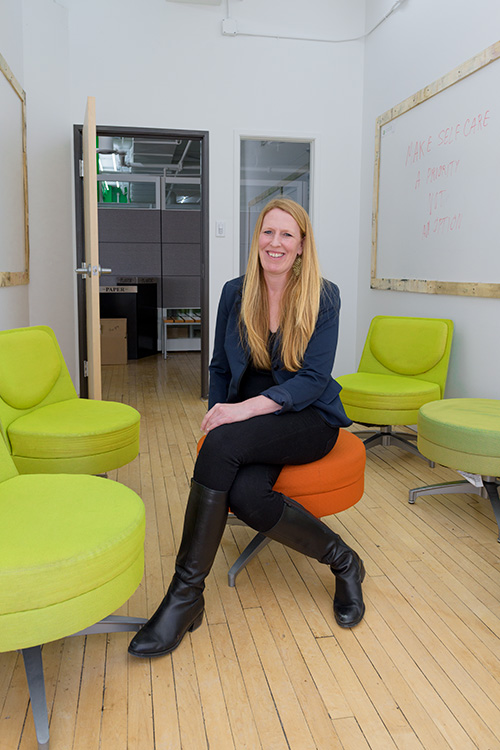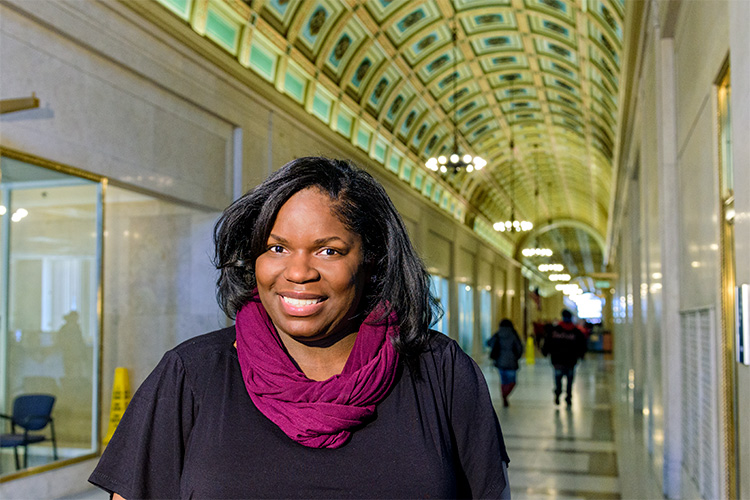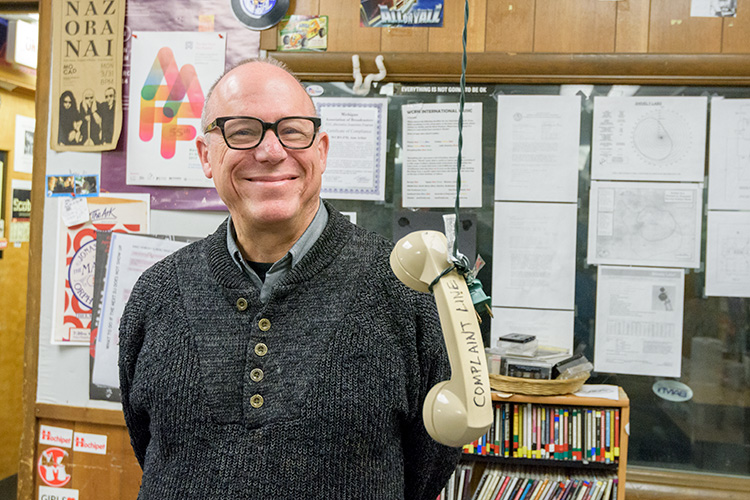The gig economy: Can you make a living freelancing in Metro Detroit?
Be your own boss, work from home, skip the commute—it's the fantasy of many an office drone. But can you survive doing it? Patrick Dunn tells us the story of a few Metro Detroiters who are living the dream.
Anna Clark says she wishes the story of how she started freelance writing was a tale of “going forth confidently in the direction of my dreams,” but the truth is less glamorous: she got laid off.
“I remember the day after that, thinking, ‘Okay, I had better really step up my freelance work so I can bring in some money while I look for other positions,'” the Detroit resident says.
Clark admits she had no faith at the time that it would be possible to make a living off her writing. But now, seven years later, she’s a full-time freelance writer who has written for major publications including The New York Times and The Washington Post
She’s just one of many who have participated in the rapidly growing “gig economy” that has taken hold not only in metro Detroit, but nationwide. A 2016 study from the Freelancers Union, a nonprofit advocating for freelancers, asserts that a whopping 35 percent of the U.S. workforce are now freelancers. Federal labor statistics also suggest growth in the amount of Americans doing short-term freelance or “gig” work—although those numbers are too outdated to really gauge what is still a new trend.

Although Clark found her way into the gig economy somewhat by chance, many others do so by choice. Detroit freelance copywriter and photographer Amy Sacka began her career working traditional full-time jobs in major advertising firms, but chose the freelance path 14 years ago to focus on her passion for writing and embrace a sense of autonomy.
“I love the thrill of success being on my shoulders,” Sacka says. “The relationships depend on me. They don’t depend on other people, and I’m confident in my relationship-building skills.”
State of the gig market
Sacka says she was “kind of concerned” about her ability to continue a freelance career when she moved home to the Detroit area in 2012 after nine years living in Portland, Oregon, and Seattle. She’d previously worked a traditional advertising job here with Campbell Ewald, but was skeptical of how robust the metro Detroit gig economy might be.
However, her fears proved unfounded. She quickly connected with local clients such as the Children’s Center, and has found regular gigs through creative recruiting services. She’s maintained relationships with clients on the west coast, but she says the portion of her gigs that are based locally is 50 percent and rising.
“When I have had to look, the work has come,” she says.
Royal Oak-based freelance creative consultant Mallory McMorrow found a similarly pleasant surprise in making the transition from the west coast to Detroit. McMorrow, whose work ranges from brand strategy to film production, moved here from Los Angeles in 2015 in order to be closer to her fiance’s work. Although she’s had opportunities to continue working with some of her old L.A. clients, she’s chosen to emphasize building new relationships here.
“The city feels much smaller than New York and L.A., which some people might say is a negative,” McMorrow says. “But there’s this sense here that everybody wants to work together towards something better … It’s easy to make connections and find other people to work with versus working in New York or L.A., where you’re competing against thousands and thousands of other people who do exactly the same thing as you do.”

McMorrow and Sacka are both fairly new to the local gig economy, but Ann Arbor freelance writer and editor Jim Manheim has been in the game since long before the term “gig economy” was ever bandied about. Manheim began writing freelance encyclopedia articles for Farmington Hills-based publisher Gale while he was in grad school in the late ’80s, a gig he continues today alongside work for the Ann Arbor Observer and Ann Arbor-based AllMusic.
“I think it’s a fair statement to say that it’s pretty good around here,” he says. “You don’t think of (Detroit) as a publishing center … For cities that are not where people move to go for publishing, I think it’s kind of a sleeper.”
A national advantage
Local freelance writers report that they’ve found an additional edge outside the local gig economy due to national media outlets’ recent renewed interest in Detroit. Detroit-based freelance writer Amber Ogden has found far more success writing about Detroit for publications outside of Michigan than she has finding local work.
“People outside this area are hungry and they want to know what’s going on here,” she says.
That hunger, however, is sometimes for a Detroit narrative that clashes with what local writers have actually experienced. Ogden wrote a story for a national publication about her rough transition from attending Detroit public schools in the Barton-McFarland neighborhood to attending college. But the story didn’t have enough “glitz and glam” for her editor.
“He made a lot of changes to it and wanted me to tell the prettier side of the story,” she says. “But at that particular time, there was no other side. This is it. This is what the narrative is.”

Clark, who also primarily writes about Detroit for national publications, has encountered a variety of frustrating perceptions about the city as well. A Detroit story is sometimes labeled “too local,” even when she suspects the same idea would play just fine if it took place in New York or L.A. She says editors often have an “anthropological” sense of Detroit, looking at the city as a series of case studies for larger problems affecting the nation.
However, those mentalities are exactly why Clark does what she does.
“A lot of people do have these hackneyed ideas about Detroit that you sometimes have to push back against, both in the pitch process and in the editing process,” she says. “But I think writers here are in a strong position because we know it. We’re the ones actually here. We’re the authorities. We’re why they’re hiring us.”
Hurdles and hustling
Although many metro Detroiters are making a full-time living exclusively in the freelance world, that lifestyle is not so attainable—or sustainable—for some. A 2016 Adobe study on the future of work found that one-third of office professionals “moonlight” at a second job, and the majority of those do so to pursue a passion. Such is the case for Ogden, who works a full-time day job and freelances on the side.
“Thank goodness it’s just me that I have to take care of, because I couldn’t imagine supporting a family on a part-time freelance salary, if that’s what you want to call it,” she says. “Things aren’t consistent.”
Detroit photographer Keenan Hastings‘ path to a freelance career was similar to Clark’s. After getting fired from a job in 2012, he started experimenting with photography in his newfound downtime and quickly found jobs shooting events. Hastings attributes his success to his strong interpersonal skills and reliance on face-to-face networking, rather than just internet marketing.
But last month he gave up the freelance life for a full-time job with the Detroit Design Festival.
“When I jumped into [freelancing] I was thinking about the creative side, and as I learned, it’s not really about the creative side,” Hastings says. “It’s about sales, and sometimes you’ve got to look in the mirror and say, ‘Do I want to be a salesman?’ And my answer this year was no. I want to be able to have somebody come to my show and look at it, not me taking pictures of somebody else at their show.”
Clark readily admits that her own path to freelancing full-time wasn’t an easy one. Early on she worked a variety of odd jobs in addition to writing, including working as an assistant to a young woman with cerebral palsy. But she says those experiences only made her a better and more knowledgeable writer. She’s grateful now to have reached a point where she feels “privileged” enough to have passed up a few full-time journalism job opportunities in favor of sticking to the freelance life.
“It does take a lot of hustle,” Clark says. “It may not be what I want to do long-term. I may change my mind. But it’s good to know that capacity is there.”
All photos by Doug Coombe.








